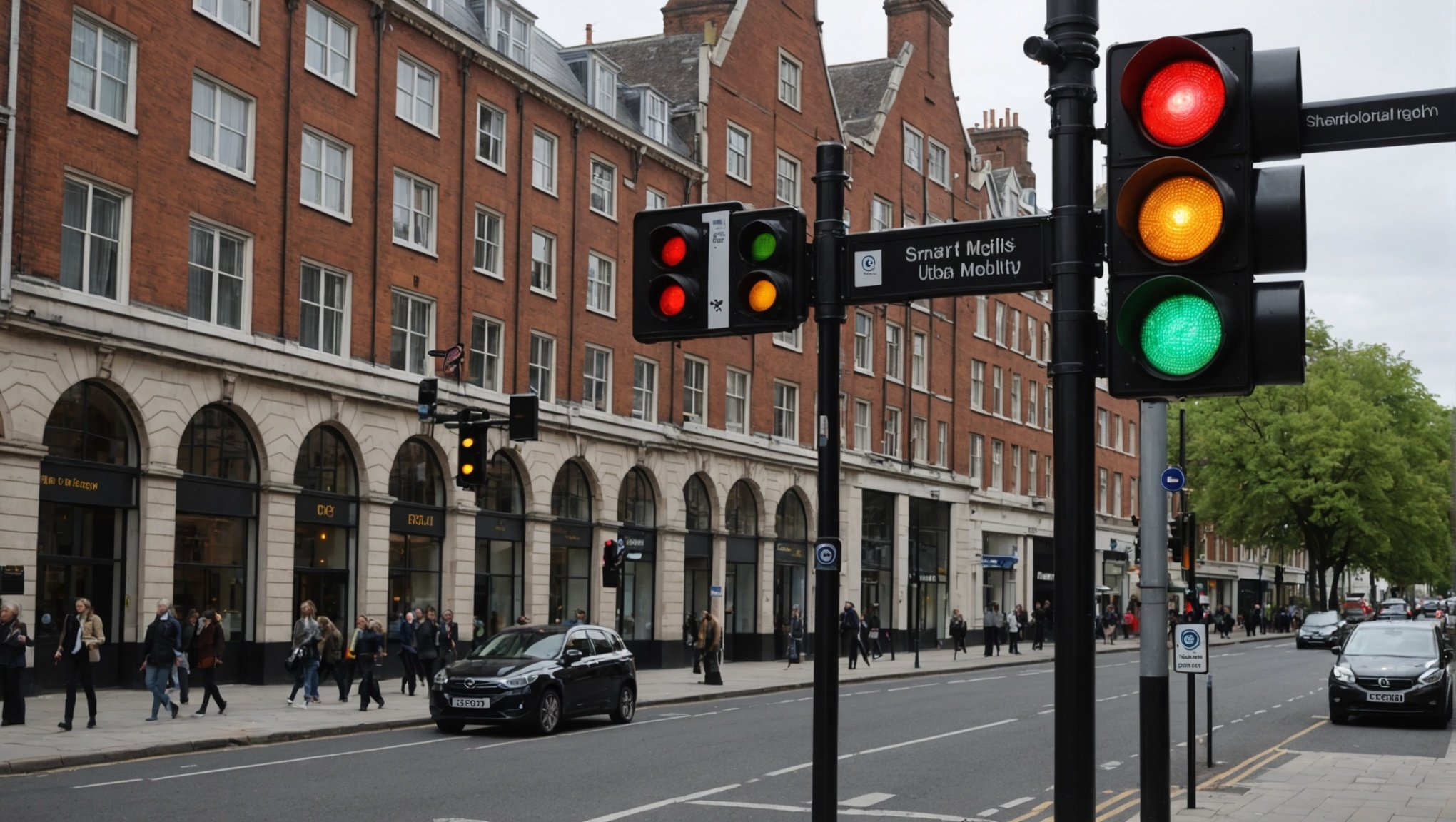Revolutionizing Urban Mobility: Harnessing Smart Traffic Lights to Enhance Traffic Flow in UK Cities
The Challenge of Traffic Congestion in UK Cities
Traffic congestion is a perennial problem in many UK cities, causing frustration, wasting time, and contributing to environmental pollution. Traditional traffic management systems often fall short in addressing these issues effectively, highlighting the need for innovative solutions. This is where smart traffic lights, powered by advanced technologies such as the Internet of Things (IoT), artificial intelligence (AI), and big data analytics, come into play.
Smart Traffic Management: The Key to Efficient Urban Mobility
Smart traffic management systems are at the heart of modern urban mobility solutions. These systems employ digitally transformative technologies to monitor and control traffic flow in real-time, alleviating congestion, reducing fuel wastage, and lowering CO2 emissions.
Also read : Transforming Retail: How Augmented Reality is Revolutionizing the Shopping Experience in the UK
Smart Traffic Monitoring
Previous research has shown that road traffic monitoring can cut fuel consumption during traffic signal idling by 40%[1]. AI-enabled traffic management systems are increasingly deployed to decrease accidents and congestion. For instance, cities like Chicago and New York have seen potential reductions in annual CO2 emissions by implementing well-timed traffic management signals.
Real-Time Data Analytics
The use of real-time data analytics is crucial in smart traffic management. Cities like Manchester are using real-time data to manage traffic lights and control congestion, minimizing delays and improving overall traffic flow[4]. This data-driven approach allows transportation authorities to make informed decisions, optimizing routes and reducing wait times.
Also to see : Transforming Retail: How Augmented Reality is Revolutionizing the Shopping Experience in the UK
The Role of LiFi Technology in Smart Traffic Lights
Light Fidelity (LiFi) technology is emerging as a significant player in enhancing smart city infrastructure, including smart traffic lights. LiFi leverages light to transmit data at high speeds, providing a secure and reliable network connection.
Dynamic Traffic Signal Adjustments
Smart traffic lights equipped with LiFi can dynamically adjust signal timings based on real-time traffic data, reducing congestion and improving traffic flow. LiFi-enabled sensors can monitor traffic density, vehicle speeds, and pedestrian movement, providing valuable data for urban planners and city managers to design more efficient transportation networks[2].
Vehicle-to-Everything (V2X) Communication
LiFi technology also promotes Vehicle-to-Everything (V2X) communication, which includes Vehicle-to-Vehicle (V2V), Vehicle-to-Infrastructure (V2I), Vehicle-to-Pedestrian (V2P), and Vehicle-to-Network (V2N) communication. This type of communication can reduce traffic congestion, minimize accidents, and improve overall road safety by providing real-time information about traffic conditions and road hazards[2].
Case Studies: Successful Implementations in UK Cities
Several UK cities have already seen significant improvements in traffic flow through the implementation of smart traffic management systems.
Manchester’s Innovative Approach
Manchester’s transport system is a prime example of how real-time data analytics can transform urban mobility. The city uses real-time data to manage traffic lights, reducing delays and improving traffic flow. The Metrolink tram network also adjusts frequency and capacity based on passenger data, enhancing the user experience[4].
London’s Data-Driven Solutions
In London, Transport for London (TfL) has optimized bus schedules and reduced wait times using big data analytics. The Oyster card system collects travel data to improve service delivery, ensuring efficient use of resources and enhancing commuter satisfaction[4].
Key Technologies in Smart Traffic Management
Several technologies are integral to the functioning of smart traffic management systems.
Big Data and Machine Learning
Big data analytics and machine learning are essential for optimizing traffic flow. By analyzing extensive datasets, cities can predict traffic patterns and adjust traffic signals accordingly. For example, predictive analytics can forecast traffic congestion and adjust signal timings to mitigate it[4].
IoT and Remote Sensing
The Internet of Things (IoT) and remote sensing technologies play a crucial role in gathering real-time data. Sensors, GPS tracking, and traffic cameras provide insights into passenger flow and vehicle performance, enabling data-driven decision making[4].
Practical Insights and Actionable Advice
For cities looking to implement smart traffic management systems, here are some practical insights and actionable advice:
- Integrate Multiple Data Sources: Consolidate data from various sources such as traffic cameras, sensors, and GPS devices to get a comprehensive view of traffic flow.
- Implement Real-Time Analytics: Use real-time data analytics to adjust traffic signals dynamically, reducing congestion and improving traffic flow.
- Adopt LiFi Technology: Consider integrating LiFi technology to enhance the speed and reliability of data transmission.
- Engage in Continuous Learning: Use machine learning algorithms to learn from traffic patterns and improve predictive analytics over time.
- Involve Stakeholders: Collaborate with urban planners, transportation authorities, and residents to ensure that the system meets the needs of all stakeholders.
Table: Comparison of Traditional vs. Smart Traffic Management Systems
| Feature | Traditional Traffic Management | Smart Traffic Management |
|---|---|---|
| Data Collection | Limited to manual observations and fixed sensors | Real-time data from multiple sources (sensors, GPS, cameras) |
| Signal Timing | Fixed timing based on historical data | Dynamic adjustments based on real-time traffic data |
| Communication | No real-time communication between vehicles and infrastructure | V2X communication enabled by LiFi technology |
| Energy Efficiency | Higher energy consumption due to inefficient lighting | Energy-efficient LED lights with smart controls |
| Decision Making | Manual decision making based on limited data | Data-driven decision making using big data analytics and machine learning |
| Public Safety | Limited real-time monitoring | Enhanced real-time monitoring and predictive analytics for improved safety |
Quotes from Experts
- “Smart traffic management solutions are not just about reducing congestion; they are about creating a more sustainable, efficient, and livable urban environment.” – Transforma Insights
- “LiFi technology is a game-changer for smart cities, providing fast, secure, and reliable connectivity that can revolutionize urban mobility.” – Oledcomm
- “The use of big data analytics in urban mobility has transformed how we manage traffic flow, reducing delays and improving overall efficiency.” – Regis Mengus
Smart traffic lights, powered by advanced technologies like IoT, AI, and LiFi, are revolutionizing urban mobility in UK cities. By leveraging real-time data analytics, these systems can significantly reduce traffic congestion, improve road safety, and enhance the overall efficiency of transportation systems. As cities continue to grow and evolve, the integration of these smart solutions will be crucial in creating more sustainable, efficient, and livable urban environments.
Future Prospects and Emerging Technologies
The future of urban mobility is intertwined with emerging technologies such as autonomous vehicles, IoT, and AI. These innovations will enable smart cities to collect and analyze data at unprecedented scales, further enhancing the efficiency and sustainability of transport systems.
- Autonomous Vehicles: Expected to revolutionize transport efficiency by optimizing routes and reducing human error.
- IoT: Will continue to enable real-time data collection, facilitating more precise traffic management.
- AI and Machine Learning: Will enhance predictive analytics, allowing for more accurate forecasting and decision making.
As we move forward, the synergy between these technologies and smart city infrastructure will be pivotal in shaping the future of urban mobility, making cities more connected, efficient, and responsive to the needs of their residents.










